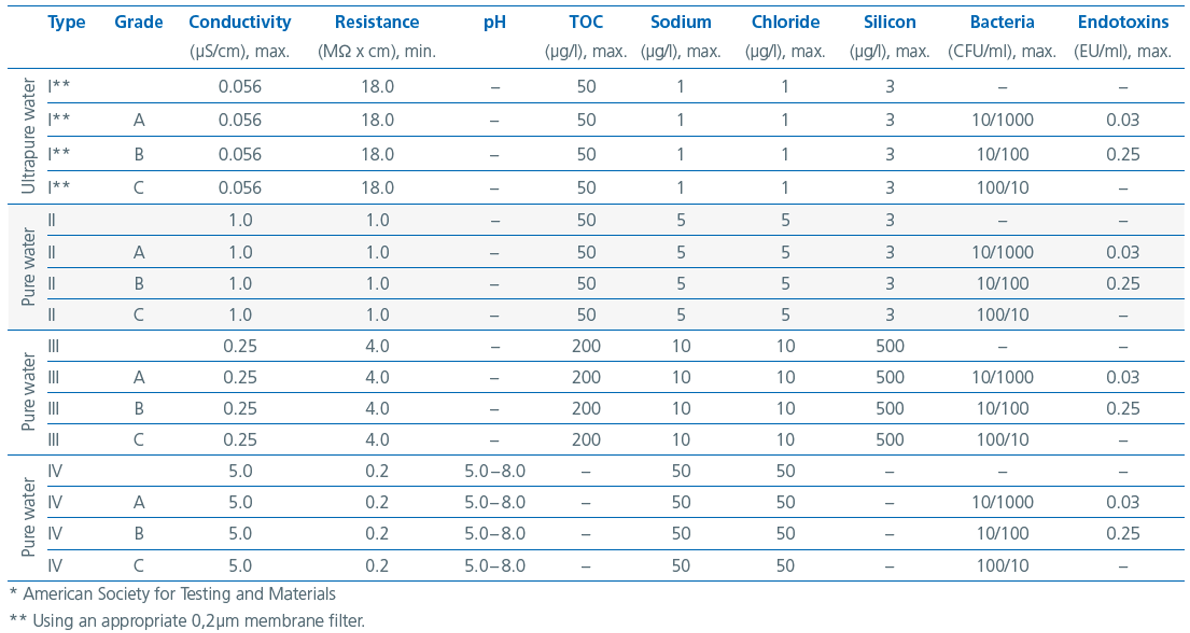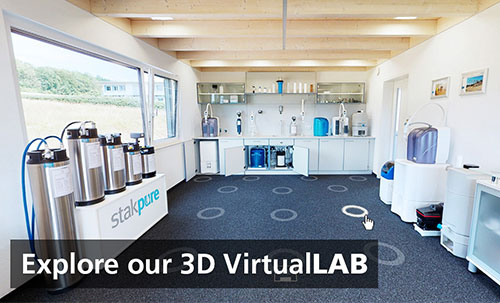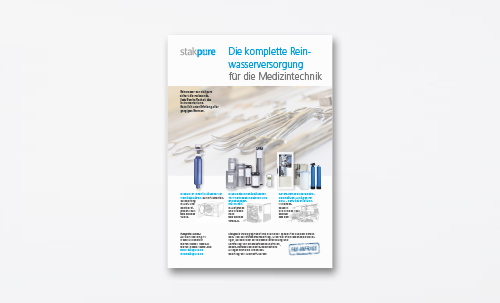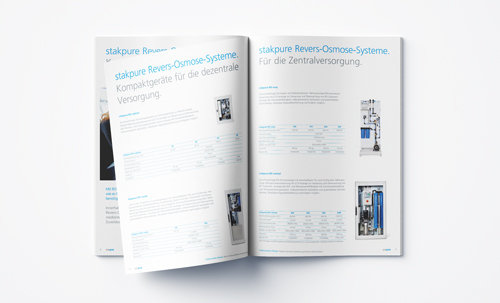Pure water of all grades.
For laboratory and medical technology.

Whether supplying pure water in hospitals & clinics for central sterilization, in medical practices for endoscopy or for large laboratory facilities and clinical analysis supply – we offer the ideal solution for any need.
Pure water for laboratory technology (ASTM)
The ASTM* D1193-06 (2011) deals with the requirements for chemical analyses and physical tests. For central laboratory water supply, i.e. feedwater for laboratory washers, autoclaves and ultrapure water systems, pure water of Type II is needed.

Pure water for the supply of analysers of Clinical Laboratory Standards Institute (CLSI)
This institute defined the quality requirements of water for clinical laboratories. The regulations that were valid up to 2006 (NCCL types 1, 2 and 3) but were then invalidated by the requirement that water must be suitable for the intended usage. Only the degree of purity of so-called “Clinical laboratory reagent water” (CLRW) is described
| Resistance | 10 MΩ x cm |
| TOC | < 500 ppb |
| Bacteria | < 10 KbE/ml |
| Particle content | Inline 0.2 μm-filter |
Pure water for the supply of cleaning and disinfection devices (DIN EN ISO 15883)
At least the use of softened water or reverse osmosis water can prevent lime deposits. Using acidic disinfectants, such as based on peracetic acid, a low chloride content can also lead to pitting corrosion. Therefore, a chloride value limit of < 50 mg/l is recommended. For the final rinse, fully demineralized water is suggested. However, for process optimization it is advisable to use fully demineralized or at least softened water for pre-wash, cleaning and intermediate wash steps. The water quality according to DIN EN 285 proves itself for the final rinse step in mechanical instrument reprocessing.
| Total hardness | < 3°dH (< 0,5 mmol CaO/l) |
| Total minerals | < 500 mg / l |
| Chloride content | < 100 mg / l |
| pH value | 5 up to 8 |
| Conductivity: | ≤ 15 μS/cm (differ from table of DIN EN 285) |
| pH value: | 5 – 7 |
| Total hardness: | ≤ 0,02 mmol CaO/l |
| Total minerals: | ≤ 10 mg/l |
| Phosphate content (P2O5): | ≤ 0,5 mg/l |
| Silicate content (SiO2): | ≤ 1 mg/l |
| Chloride content: | ≤ 2 mg/l |
| Microbiological: | min. drinking water quality according to TrinkwV |
Pure water for steam and large-size sterilizers (DIN EN 285 – Annex B)
Proposed maximum values for feed water pollution:
| Evaporation residue | ≤ 10 mg/l |
| Silicates (SiO2) | ≤ 1 mg/l |
| Iron | ≤ 0.2 mg/l |
| Cadmium | ≤ 0.005 mg/l |
| Lead | ≤ 0.05 mg/l |
| Heavy metal residue except iron, cadmium and lead | ≤ 0.1 mg/l |
| Chlorides (Cl) | ≤ 2 mg/l |
| Phosphates (P2O5) | ≤ 0.5 mg/l |
| Conductivity (at 25 °C) | ≤ 5 μS/cm |
| pH value (degree of acidity) | 5 bis 7.5 |
| Appearance | colorless, clear, without deposits |
| Hardness (sum of alkaline earth ions) | ≤ 0.02 mmol/l |



